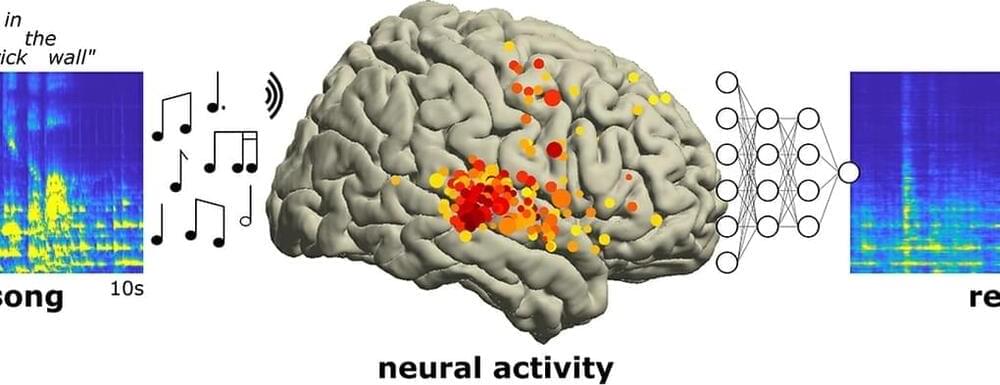Supermassive black holes sit at the center of many galaxies and are often surrounded by accretion disks that they feed on. Scientists observed a previously unexplored region near one – by accident.


Interview with Prof. Marc Sachon for the event “Artificial Intelligence: Using your power for good” (IESE Global Alumni Reunion 2022).
+ “Artificial Intelligence for Executives” Program:
https://execedprograms.iese.edu/strategic-management/artificial-intelligence/
+ “The Power of AI to Transforming Your Business Program:
https://execedprograms.iese.edu/strategic-management/artific…-business/
An exploration of how old the first alien civilizations could be, or how early in the history of the universe were planets possible.
My Patreon Page:
https://www.patreon.com/johnmichaelgodier.
My Event Horizon Channel:
https://www.youtube.com/eventhorizonshow.
Music:
This book, ‘The Singularity Is Near’, predicts the future. However, unlike most best-selling futurology books, its author, Kurzweil, is a renowned technology expert. His insights into the future are not technocratic wild fantasies but are rooted in his profound contemplation of technological principles.
This audio informs us that, due to Moore’s Law, the pace of human technological advancement in the future will far exceed our expectations. By 2045, we will reach the technological ‘Singularity’, which will profoundly alter our human condition, and technology may even enable humans to conquer the universe within a millennium.
The author, Ray Kurzweil, is a true tech maestro. He has been inducted into the National Inventors Hall of Fame in the U.S., is a recipient of the National Medal of Technology, holds 13 honorary doctorates, has been lauded by three U.S. presidents, and is dubbed by the media as the ‘rightful heir to Thomas Edison’.
In the audio, you will hear:
Moore’s Law has been around for 40 years; can it continue?
Why is it said that by 2045, humans will reach a technological Singularity?
Why are future humans described as a set of algorithms?
Is artistic creation the last bastion between humans and artificial intelligence?
BookLink:https://amzn.to/45akzPk.

Kali Linux 2023.3, the third version of 2023, is now available for download, with nine new tools and internal optimizations.
Kali Linux is a Linux distribution created for ethical hackers and cybersecurity professionals to perform penetration testing, security audits, and research against networks.
With this release, the Kali Team says there are not many new features, with most of the changes done internally to increase the overall reliability and optimization of the project.
AI really is getting bigger, better and crazier, and in this video I’ll show you the top 10 AI tools that are changing EVERYTHING!! You Guys have gotta try them out and let me know in the comments which AI was your favorite one!
AI TEXT TO VIDEO — https://runwayml.com/
AI ART 2.0 — https://clipdrop.co/
AI MIXING — https://www.ostagram.me/
AI PHOTO EDITING — https://www.adobe.com/uk/products/photoshop/
AI EMAILS — https://workspace.google.com/labs-sign-up/
AI QR CODES — https://www.qrcraft.xyz/
AI DEEPFAKES — https://reface.ai/unboring/
AI WORLDS — https://skybox.blockadelabs.com/
AI TRANSFORMATION — https://wonderdynamics.com/
AI FOREVER — https://diffusionbee.com/
FREE WALLPAPERS
https://www.haylsworld.com/free-downloads.
🌟 SOCIAL 🌟
• SHORTS — https://www.youtube.com/c/HaylsWorldShorts.
• INSTAGRAM — http://instagram.com/haylsworld.
• TWITTER — https://twitter.com/HaylsWorld.
• WEBSITE — https://www.haylsworld.com/
🛒 AMAZON SHOP 🛒
https://www.amazon.com/shop/haylsworld?tag=lifeboatfound-20.
🎵 MUSIC 🎵



🔒 Keep Your Digital Life Private and Stay Safe Online: https://nordvpn.com/safetyfirst.
Welcome to our channel! In this exciting video, we delve into the fascinating realm of artificial intelligence (AI) and explore the question that has intrigued tech enthusiasts and experts alike: “How powerful will AI be in 2030?” Join us as we embark on a captivating journey into the future of AI, examining the possibilities, advancements, and potential impact that await us.
In the next decade, AI is poised to revolutionize numerous industries and transform the way we live and work. As we peer into the crystal ball of technological progress, we aim to shed light on the potential power and capabilities that AI could possess by 2030. Brace yourself for mind-blowing insights and expert analysis that will leave you in awe.
We begin by exploring the current state of AI and its rapid advancements. From machine learning algorithms to neural networks and deep learning models, AI has already demonstrated exceptional prowess in various fields, including healthcare, finance, transportation, and more. By building upon these achievements, AI is set to evolve exponentially, opening doors to a future where intelligent machines collaborate seamlessly with humans.
Throughout this video, we delve into key areas where AI is expected to make significant strides by 2030. We discuss advancements in natural language processing, computer vision, robotics, and autonomous systems. Witness the potential of AI-powered virtual assistants, autonomous vehicles, medical diagnostics, and even the integration of AI in our daily lives.
To provide a comprehensive perspective, we draw insights from leading AI researchers, industry pioneers, and thought leaders who offer their expert opinions on the future trajectory of AI. Their invaluable insights help us paint a vivid picture of the exciting possibilities that await us in the next decade.
Join us on this thought-provoking journey into the future, as we ponder the ethical implications, challenges, and potential risks that arise with the growing power of AI. By understanding the trajectory of AI development, we can prepare ourselves for a future where humans and intelligent machines coexist harmoniously.